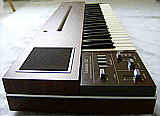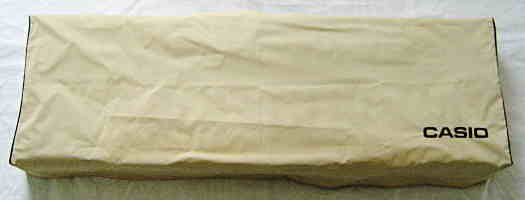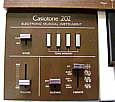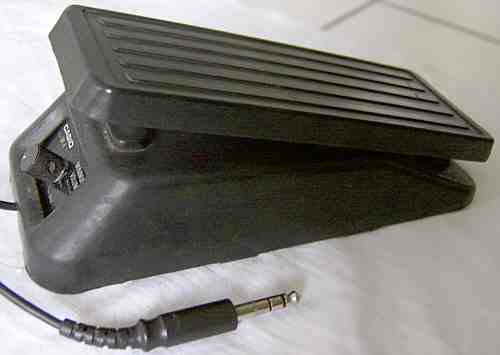| early Casio with unusual semi- analogue sound |
This instrument from 1981 (service manual date) was the direct successor of the Casiotone 201 (world first Casio keyboard) and behaves very similar. The Casiotone 202 sound bank had already 49 sounds at a time where other preset keyboards still had maximum about 12 or 20 preset sounds. But otherwise it has no selectable envelopes anymore, which basically doubled the number of available sounds of the 201, but the Casiotone 202 instead had 3 different vibrato variants and a real sustain switch. This instrument was also released with a white/ aluminium coloured case.
 |
 |
Because both instruments are very similar, I only describe here the difference to the Casiotone 201.
 |
 |
 |
 Unlike
Casiotone
201, the case of this instrument already has the control panel
and speaker to the left.
Unlike
Casiotone
201, the case of this instrument already has the control panel
and speaker to the left.  Despite it is still of genuine wood, the case of the Casiotone 202
is more sharp- edged rectangular and looks cheaper, more banal and way
less elegant. E.g. the bottom is simply painted brown while on the 201
it was entirely covered with imitation woodgrain, and also the connector
terminal is a cheaper plastic design. The aluminium rail under the keys
is the only noble looking part. The boring nut tree brown case design of
the 202 with its silver rectangular plastic buttons and the silver
plastic speaker frame resembles much certain 1980th Grundig table
radios those looked so establishment that they were mainly bought by senior
people. (The 202 was also released in a white and aluminium case version,
which appears to be rarer.) The rear part of this case is also unnecessary
bulky in comparison to the compacter 201. But at least the control panel
writing is now on the case itself and not on a fragile plastic foil overlay
like with the 201. (Some people also call this instrument
CT-202,
but the "CT" in Casio model names was introduced later.)
Despite it is still of genuine wood, the case of the Casiotone 202
is more sharp- edged rectangular and looks cheaper, more banal and way
less elegant. E.g. the bottom is simply painted brown while on the 201
it was entirely covered with imitation woodgrain, and also the connector
terminal is a cheaper plastic design. The aluminium rail under the keys
is the only noble looking part. The boring nut tree brown case design of
the 202 with its silver rectangular plastic buttons and the silver
plastic speaker frame resembles much certain 1980th Grundig table
radios those looked so establishment that they were mainly bought by senior
people. (The 202 was also released in a white and aluminium case version,
which appears to be rarer.) The rear part of this case is also unnecessary
bulky in comparison to the compacter 201. But at least the control panel
writing is now on the case itself and not on a fragile plastic foil overlay
like with the 201. (Some people also call this instrument
CT-202,
but the "CT" in Casio model names was introduced later.)
Like with Casiotone 201, the sounds consist of 4 mixed suboscillators with different stair shaped waveforms and digital volume envelopes. Much like squarewave based instruments the sounds are a bit buzzy in the bass range. The sound synthesis is very similar like with 201, but unlike the latter, here the pipe organs have no chorus anymore (possibly the simplified hardware can not detune its suboscillators anymore) but otherwise when a key is trilled with sustain, now each new note occupies a new sound channel, which produces a great phasing sound and volume increase effect although this eats up polyphony. Like the 201, the sounds are not bad, although most of them have rather little to do with their names. Many sounds resemble more a Clavinet or have a brassy bass range or too much trebles. Unfortunately there is no "tone" switch anymore to select between 2 envelope variants, thus basically the 201 had even more presets than the 202 when we count them as different sounds.
The percussive sounds are selected by the white keys, while the continuous sounds (like organ tones) are selected by the black keys. Unlike with the 201, Casio now first time dared to name a sound "piano" (not only "Elec. Piano"), although like with many squarewave based instruments it is not that realistic. "Piano 1" is a bit buzzy in the bass range brassy in the mids and resembles more a picked string with higher notes (much like a Clavinet), while "Piano 2" has more realistic higher notes but a bass range like an acoustic guitar. The "Funky Clavi" is a buzzier "Piano 1" variant. The "Celesta" is more a Rhodes piano and not very percussive. The "Clavichord" has a percussive attack phase but a buzzy bass range (resembles more a Russian balalaika). Both "harpsichords" have a harsh attack phase and too little presence. The "Synthe- Sound" is a harsh and very dry sort- of picked string (like a harpsichord), that goes "enng!" in the bass range and seems to be a predecessor of the great "Frog" on Casio MT-60. The "Harp 1" resembles more a music box while the other 3 harps resemble more picked strings like intended. Both kotos are ok; the "Koto 2" is harsher and dry. The "Elec. Sound" is a sort-of pipe organ that fades quiet. The "Taisho Koto" (instrument see here) is a bright and impulsive picked string with dry bass range. The guitars are a little brassy but ok. "Guitar" 5 & 6 have bright steel strings. "Guitar 7" sounds thin and unrealistic (more like a banjo but with an unpercussive bass range). The "Banjo" sounds percussive but not hollow enough and has a bright and dry buzzing bass range. "Elec. Guitar" 1 & 2 sound undistorted, bright and with long sustain phase. "Elec. Guitar 3" fades a bit duller (like through a wahwah- pedal?). The "Elec. Bass" sounds brassy and has a buzzy bass range.
The "Pipe Organ 1" is bright, 2 has a duller multipulse squarewave organ timbre (sounds rather of home organ) with sonorous bass range. 3 is a duller pipe organ while 4 is another multipulse timbre (pipe organ with nice bass range). The "Elec. Organ" is a bright timbre with hollower bass range (still pipe- like). "Bandonion" is a thin and harsh multipulse timbre that also sounds more of metal organ pipes. The "Accordion" is not reedy enough and resembles more bright wooden organ pipes (or a very muffled reed organ?). The "Bag Pipe" is a thinner version of the latter, way too dull to sound realistic despite the hardware has the correct waveform (used in the "Synthe- Sound"). The "Oboe" sounds ok, although a bit trumpet- like and has a buzzy bass range. The "Clarinet" sounds correct, the "Flute" (recorder?) too. The "Sakuhachi" strongly crossfades the waveform in its slow attack phase, which sounds synthesized; in the mids and bass range it resembles a "wah"- voice. The "Horn" is not that brassy and in the bass range more a dull reed organ. The "Fluegelhorn" sounds a bit brassier and more natural, also due to a more natural attack phase. The "Trumpet" sounds only credible in the mids but with buzzy bass and flute- like high notes. The "brass" is duller but also little realistic. The "bass" is rather a tuba. The "Cello" fades duller and sounds a bit brassy. The "Viola" sounds similar and fades less strong. The "Violin" fades a bit brighter and sounds fairly realistic in the mids. In comparison to Casiotone 201 unfortunately the cute "WA WA" voice is gone. When sustain is off, all sounds stop almost immediately after releasing the key. The sound presets itself also contain neither vibrato nor tremolo.
To select sound presets, the "mode" switch has to be moved from "play"
to "set", which will also assign the selected sound to the currently pressed
"tone memory" button switch. (The Casiotone 201 had a slide switch here).
The sounds are then selected by the keyboard keys. Also here the selected
sound is played as a hint during the selection key press, but only when
the key is held down longer than about 0.2s. When the "mode" switch is
set back to "play", the keyboard behaves normal again. The 4 locking OBS
"tone memory" buttons can select between 4 of these sound presets during
play, although they make no good realtime sound effect since they responds
with a delay of about 0.25s. After power on, the 4 "tone memories" contain
the sound presets {Piano 1, Funky Clavi, Pipe Organ 1, Elec. Bass}. This
instrument came with the volume pedal Casio VP-1.
circuit bending detailsThe inner working of the Casiotone 202 strongly resembles its predecessor Casiotone 201; both CPUs (NEC D788G and D789G) are members of the D77xG family and wired parallel in the same manner, but here they have a tuning trimmer (1134 kHz in service manual) instead of being crystal clocked.
The waveforms of the D788G and D789G CPU are slightly more sophisticated (less straight and ramp sections) and focused on emphasizing the pluck noise of picked strings with various stair shaped spikes (resembling old skyscrapers). However there are no organ timbres with phasing anymore, nor plain sinewaves. The analogue filters also here are controlled by a lot of CPU pins (D788G uses pin 40, 41, 46, 47, D789G uses all pins 40..47). The Consonant-Vowel hardware has for each CPU a different filter block. "Consonant" (D788G) has HPF {plain, 3kHz} and LPF {mute, 3.4 kHz,1.5 kHz, plain}. "Vowel" (D789G) has LPF {mute, 1.9 kHz, 1.1 kHz, 0.8 kHz} and 2 volume steps. keyboard matrixThe keyboard matrix layout is generic for D77xG CPUs. The keyboard matrix outputs are taken from only one CPU (D788G) but received by both. To prevent running out of sync by e.g. too short key presses, there is a bank of flipsflops (TC40174, 2x TC4013) buffering keys and switches to ensure that both CPUs see always the same matrix inputs.Someone e-mailed me some info about additional keyboard matrix eastereggs, those are also explained in the bulletin "Modifying the Casiotone Instruments" by Robin Whittle. They are selected by each a locking switch in series to a diode at the following CPU pins:
CPU pin 17->30
CPU pin 16->26
CPU pin 17->25
CPU pin 16->25
CPU pin 16->31
CPU pin 18->29, 18->30 These strange C2 key doublets use a different sound channel than their normal versions and change pitch and timbre when held or trilled during play of other notes; it also depends on vibrato and other settings. Sometimes each strange key press plays the note in different octaves. |
 |
 |
 |
A successor of the Casiotone 202
was the similar Casio
CT-8000 keyboard (additional stereo chorus, reverb, only 1 vibrato,
no speaker), which was part of the ultra- rare modular stage organ Symphonytron
8000.
| removal of these screws voids warranty... | ||
 |
||
|
|